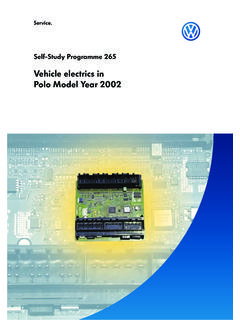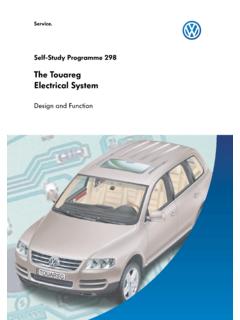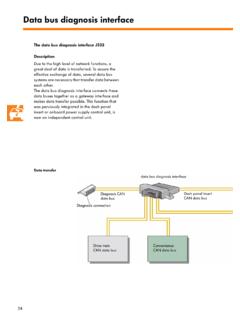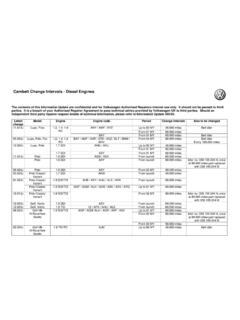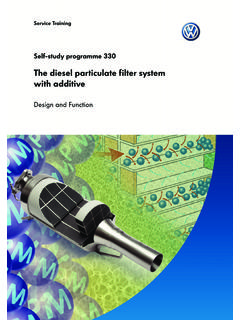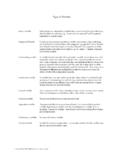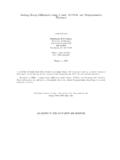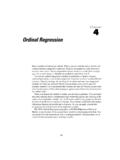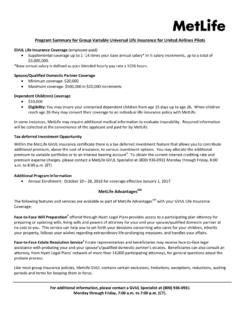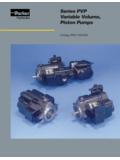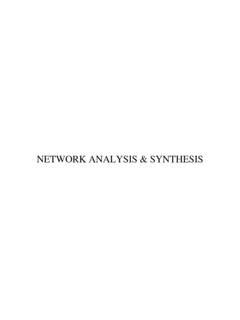Transcription of Service. - VolksPage.Net
1 Va r i a b l e Va l ve T i m i n gwith fluted variatorDesign and FunctionSelf-study programme AttentionNoteThe self-study programme presents the design and operation of new contents are not refer to the intended Service literature for current instructions for testing, settings and demands on combustion engines continue to grow. On one hand, customers want more power and torque, while on the other, one cannot lose sight of fuel economy and increasingly stringent emissions laws. In regard to valve timing , this means that engine-speed and load dependent adjustment of the inlet and exhaust camshafts is indispensable. Therefore, of course, adjustment systems are continuously being improved in technical design as well as in means of this self-study programme, we would like to introduce to you the design and operation of the new camshaft adjuster with fluted variators. At Volkswagen, first the litre V6 and the litre V5 engines will be equipped with this system.
2 Later other engines, such as the W8 and W12 engines will be equipped with this variable valve timing of ContentsIntroduction .. 4 variable valve timing .. 6 Design.. 6 Operation .. 8 Advancing the inlet camshaft..10 Retarding the inlet camshaft .. 11 Inlet camshaft regulation .. 12 Exhaust camshaft.. 13 Exhaust camshaft, basic setting .. 14 Exhaust camshaft, idle .. 15 Oil system .. 16 Engine management .. 17 System overview .. 17 Circuit diagram .. 25 Self-diagnosis.. 26 Test your knowledge ..274 IntroductionThe task of variable valve timingVariable valve timing has the task of setting the most advantageous valve timing for the particular engine for the operating modes idle, maximum power and torque as well as exhaust gas idle, the camshafts are set so that the inlet camshaft opens late and, consequently, closes late as well. The exhaust camshaft is set so that it closes well before TDC. Due to the minimal gas residue from combustion, this leads to smooth achieve good power at high engine speeds, the exhaust valves are opened late.
3 In this way, the expansion of the burned gases can act against the pistons inlet valves open after TDC and close well after BDC. In this way, the dynamic self-charging effect of the entering air is used to increase :Inlet opensIc:Inlet closesEo:Exhaust opensEc:Exhaust closesEcEoIoIcBDCTDCEcEoIoIcBDCTDC246_00 1246_0025 Torqu eTo achieve maximum torque, a high degree of volumetric efficiency must be attained. This requires that the inlet valves be opened early. Because they open early, they close early as well, which avoids pressing out the fresh exhaust camshaft closes just before TDC. Exhaust gas recirculationInternal exhaust gas recirculation can be achieved by adjusting the inlet and exhaust camshafts. In this process, exhaust gas flows from the exhaust port into the inlet port while the valves overlap (inlet and exhaust valves are both open). The amount of overlap determines the amount of recirculated exhaust gas. The inlet camshaft is set so that it opens well before TDC and the exhaust camshaft does not close until just before TDC.
4 As a result, both valves are open and exhaust gas is recirculated. The advantage of internal exhaust gas recirculation over external exhaust gas recirculation is the fast reaction of the system and very even distribution of the recirculated exhaust illustrated valve timing is intended to demonstrate the basic principle and the effects of variable camshaft timing . Of course every engine has valve timing adapted to its mechanics and its engine camshaft fluted variatorExhaust camshaftfluted variatorControl housingN205N318246_146 Oil gallery to ring channels in camshaftsThe variable valve timing system consists of the following components: Two fluted variatorsThe fluted variator for adjusting the inlet camshaft is fitted directly on the inlet camshaft. It adjusts the inlet camshaft according to signals from the engine control unit. The fluted variator for adjusting the exhaust camshaft is fitted directly on the exhaust camshaft.
5 It adjusts the exhaust camshaft according to signals from the engine control unit. Both fluted variators are hydraulically operated and are connected to the engine oil system via the control valve timingDesign of variable valve timingThe illustration shows the arrangement of the variable valve timing system on the V5 and V6 The control housingThe control housing is attached to the cylinder head. Oil galleries to both fluted variators are located in the control housing. Two solenoid valvesThere are two solenoid valves located in the control housing. They direct oil pressure to both fluted variators according to the signal from the engine control unit. Inlet camshaft timing adjustment valve -1- (N205) is responsible for the inlet camshaft, and exhaust camshaft timing adjustment valve -1- (N318) is responsible for the exhaust illustration shows the arrangement of the variable valve timing system on one cylinder head of the W8 and W12 camshaftfluted variatorExhaust camshaftfluted variatorControl housingN205N318246_025 Oil gallery to ring channels in camshaftsThe design and operation of the illustrated engine versions is the same.
6 They differ only in the arrangement and shape of some engine control unit controls the variable valve timing . To adjust the camshafts, it requires information about engine speed, engine load and temperature and the positions of the crankshaft and camshafts. To adjust the camshaft, the engine control unit actuates the solenoid valves N205 and N318. They in turn open oil galleries in the control housing. Engine oil flows through the control housing and camshaft into the fluted variators. The fluted variators turn and adjust the camshaft according to the specifications of the engine control valve timingOperation of variable valve timingInlet camshaftExhaust camshaftN205N318 Engine control unitHall sender 1 G40 Hall sender 1 G163 Oil pumpEngine speedAir mass and air temperature (engine load)Coolant temperature246_0129 Outer rotorInner rotorOil galleries246_155 This section goes into more detail about the adjustment of the camshafts.
7 The parts, the design and the operation are the subject of the following camshaft adjustmentThe inlet camshaft is regulated by the engine control unit over the entire speed range of the engine. The maximum adjustment is 52 CA. The adjustment is dependent on the adjustment map stored in the engine control of the fluted variator for the inlet camshaftThe adjusting mechanism consists of: Housing with outer rotor(directly joined to timing chain) Inner rotor(directly joined to camshaft)Fluted variator10 variable valve timingThe inlet camshaft is set in the position inlet valves open before TDC for exhaust gas recirculation and for increasing torque. To change the position, the engine control unit actuates inlet camshaft timing adjustment valve 1 (N205). When actuated, the valve moves the control the control housing, the oil gallery for timing advance is opened according to the degree of adjustment. Consequently, the engine oil under pressure flows through the control housing into How the camshaft is advancedthe ring channel in the camshaft.
8 Then the oil flows through the five drillings in the face of the camshaft into the five advance chambers of the fluted variator. There it presses against the flutes of the inner rotor. The inner rotor turns relative to the outer rotor (and crankshaft), turning the camshaft with it. Consequently, the camshaft turns further in the direction of crankshaft rotation and the inlet valves open pistonControl housingRing channelsFrontal drillings246_150 Engine oil pressureOil returnOil returnInlet camshaftAdvance oil galleryIf the variable valve timing fails to function, the fluted variator will be pressed by the oil pressure to the basic position of 25 after the engine is idling or when a great deal of power is required from the engine, the inlet camshaft is rotated so that the inlet valves open late, that is, after TDC. To retard the inlet camshaft, the engine control unit actuates inlet camshaft timing adjustment valve 1 (N205).
9 The solenoid valve opens the gallery for timing retardation by moving the control piston. Oil flows through the control housing into the ring channel of the camshaft. The oil flows through drillings in the camshaft to the pocket hole of the securing bolt for the camshaft adjuster. From there, it flows through 5 drillings in the camshaft How the camshaft is retardedadjuster into the oil chamber for timing retardation behind the flutes of the inner rotor. The oil presses the inner rotor and the camshaft in the direction of camshaft rotation and the valves open the same time that the oil gallery for timing retardation opens, the control piston opens the oil return for the gallery for timing advance, relieving pressure in it. The rotation in the direction of retardation presses the oil out of the timing advance oil chamber which flows out through the timing advance oil hole for securing boltControl pistonControl housingInner fluteRing channelFrontaldrillingEngine oil pressureOil returnOil returnTiming retardationoil gallery12 Regulation enables continuous variation of the inlet camshaft between advanced and retarded, whereby the total variation is a maximum of 52 crankshaft angle.
10 On the basis of the Hall sender signal, the engine control unit detects the momentary position of the inlet camshaft. The camshafts can then be adjusted according to the map saved in the engine control unit. When actuated by the engine control unit, inlet camshaft timing adjustment valve 1 (N205) pushes the control piston in the direction, for example, of advanced timing . Oil pressure travels through the control housing into the variable valve timingHow regulation workscamshaft adjuster and presses the camshaft in the advanced position. Pushing the control piston in the advanced direction automatically opens the oil return of the oil channel for retarding timing . When the desired angle of adjustment is attained, the control piston is moved by the actuation of inlet camshaft timing adjustment valve 1 (N205) to a position in which the pressure is held in both chambers of the adjuster. If the timing is later retarded, the process runs in the opposite camshaftExhaust camshaft adjustmentAs you saw in the preceding pages, the inlet camshaft is regulated by the control unit.
